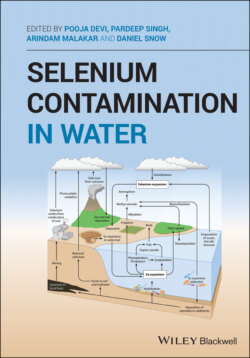Читать книгу Selenium Contamination in Water - Группа авторов - Страница 17
1.3 Selenium Reduction Technologies Used in China
ОглавлениеNanoscale zero‐valent iron (nZVI) is the most widely applied nanomaterial as an adsorbent for groundwater and hazardous waste treatment. It is also effective for selenium treatment and removal. Batch experiments have been conducted and show that nano‐ZVI has approximately a removal rate three times or higher than those of micro‐scale iron, nanoscale iron oxides, Fe(OH)3, nanoscale TiO2, and activated alumina for selenium removal (Ling et al. 2015). ZVI or nano‐ZVI is effective for SeVI removal from wastewater by reducing to more adsorptive SeIV and/or to insoluble Se species (i.e. Se0, SeI, and SeII). A key role is known to be played by dissolved Fe2+ in the reductive removal of selenate by ZVI. There are two major roles for Fe2+: (i) it participates in selenate reduction directly as partial electron donor with a Fe2+:Se stoichiometry of ~1:1, and (ii) helping in the transformation of the passive layer on iron grain and corrosion products to magnetite, favoring electron transfer and thus enhancing selenate removal. ZVI was the main electron donor. In a ZVI‐SeVI‐Fe2+ system, sequential reduction of selenate is reported where elemental Se was the dominant reductive product. Selenate reduction by ZVI assisted by Fe2+ has been identified as a sustainable treatment method for wastewater contaminated with selenate (Tang et al. 2014).
It was observed in the trials that the removal efficiency of Se (VI) by ZVI was only 4.8% within 120 minutes, although a much higher removal efficiency (62.1%) was obtained by nZVI. Owing to its smaller particle size (approximately 100 nm), nZVI has a higher capacity for removal of Se (VI) than ZVI (approximately 150 m). The smaller size of the iron particles suggests a greater surface area that gives more stable Se (VI) reaction sites. In comparison, the removal efficiency of Se (VI) by nZVI/Al‐bent was 95.7%, which was far higher than that of nZVI (62.1%). It suggests that there is a synergistic impact on the elimination of Se (VI) in the nZVI/Al‐bent composite method (Li et al. 2015). A study demonstrated that iron oxides and aluminum oxide are effective adsorbents for Se removal (Kuan et al. 1998; Sheha and El‐Shazly 2010; Sharrad et al. 2012). Coagulation was found to be an effective process for removal of metal from water (Hu et al. 2015). They found that the Fe‐based coagulant was much more efficient than the Al‐based coagulants. It was further suggested that researchers’ pre‐reduction of Se (VI) to Se (IV) seems to be necessary to achieve effective Se removal. A synergistic effect of using ZVI was demonstrated by Liang et al. (2015) with magnetic effect and it was found that removal efficiency increased, with a reduction in removal time at a pH of 6.0. Graphene nano sheets, as a novel nano adsorbent, can also be used for removing various pollutants from water by certain modifications. To overcome the structural limits of graphene (aggregation) and graphene oxide (hydrophilic surface) in water, sulfonated graphene (GS) is prepared by diazotization reaction using sulfanilic acid (Shen and Chen 2015). Another technology demonstrated for removal of selenium from water is by sequestration by Cationic Layered Rare Earth Hydroxide Y2(OH)5Cl·1.5H2O. One study confirmed that Se (IV) and Se (VI) are successfully sorbed onto Y2(OH)5Cl·1.5H2O, which is also further supported by Raman and EDS measurements (Zhu et al. 2017). Another study demonstrated a promotional effect of the use of Mn2+ and Co2+ selenate removal by ZVI. It was found that Selenite (SeIV) was the predominant reductive product in the presence of Co2+; however, selenite and elemental Se (Se0) were the main reductive products in the presence of Mn2+. But this process shows promotional effect in anaerobic conditions (Tang et al. 2014).
Taking the role of AI further, there is another powerful area of predictive modeling which is a method used in predictive analytics to generate a statistical visualization of future behavior. Predictive analytics is the domain of data mining related to anticipating likelihoods and inclinations. Alternatively, AI deals with intelligent acts, i.e. the activities that describe them as intelligent. Subsequent to the thought process, the sole purpose is to evaluate the influence of AI algorithms for the implementation of intelligent predictive models. On piece of promising research (Pinto et al. 2009) answers many crucial issues by construction predictive models. These models stimulate prediction of manganese and turbidity echelons in treated water, to guarantee that the water supply does not distress community healthiness in a undesirable mode and observes the existing regulation. Additionally, popular supervised classification algorithms such as decision trees and the unsupervised k‐means algorithm build clustering models.
Recently, it has been interesting to note that the presence of selenium in plants has been modeled to show a tight borderline limit between nutritious prerequisite and toxic supplement in plants (Soil Science Society of America 2008). The AI algorithms beautifully model how the steep dose response curve caused by bioaccumulation properties have led to the description of selenium as a “tinderbox” modeled through anthropogenic events.
